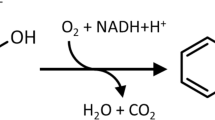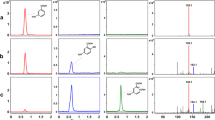Abstract
We have cloned DNA fragments of plasmid pFL40 from Alcaligenes xylosoxidans ssp. denitrificans ABIV encoding a D,L-2-haloalkanoic acid halidohydrolase (DhlIV). A 6.5-kb EcoRI/SalI-fragment with inducible expression of the halidohydrolase was cloned in Pseudomonas fluorescens and Escherichia coli. A 1.9-kb HindII-fragment demonstrated expression of the dehalogenase only due to the presence of the promoter from the pUC vector in Escherichia coli. The nucleotide sequence of this DNA-fragment was determined. It had an open reading frame coding for 296 amino acid residues (molecular weight of 32783 D). The dhlIV gene showed sequence homology to a short segment of a D-specific dehalogenase (hadD) from Pseudomonas putida AJ1, but not to any other known DNA sequences. Restriction enzyme patterns indicated similarity between dhlIV and the D,L-isomer specific dehI dehalogenase gene from Pseudomonas putida PP3. There are some indications from restriction enzyme patterns and initial sequencing data, that a gene encoding a σ54 activator protein, similar to the dehR Iregulatory gene from Pseudomonas putida PP3 is located upstream of dhlIV. In contrast to DehI, dehalogenation of D-or L-chloropropionic acid by the DhlIV-protein leads to lactic acid of inverted configuration.
Similar content being viewed by others
References
Allison N, Skinner AJ & Cooper RA (1983) The dehalogenase of a 2,2-dichloropropionate-degrading bacterium. J. Gen. Microbiol. 129: 1283–1293.
Barth PT, Bolton L & Thomson JC (1992) Cloning and partial sequencing of an operon encoding two Pseudomonas putida haloalkanoate dehalogenases of opposite stereospecificity. J. Bacteriol. 174: 2612–2619.
Bergmann JG & Sanik J (1957) Determination of trace amounts of chlorine in naphtha. Analytical Chem. 29: 241–243.
Brokamp A & Schmidt FRJ (1991) Survival of Alcaligenes xylosoxidans degrading 2,2-dichloropropionate and horizontal transfer of its halidohydrolase gene in a soil microcosm. Curr. Microbiol. 22: 299–306.
Brokamp A, Schwarze R & Schmidt FRJ (1996) Homologous plasmids from soil bacteria encoding D, L-halidohydrolases. Curr. Microbiol., in press.
Cairns SS, Cornish A & Cooper RA (1996) Cloning, sequencing and expression in Escherichia coli of two Rhizobium sp. genes encoding haloalkanoate dehalogenases of opposite stereospecificity. Eur. J. Biochem. 235: 744–749.
Clewell DB & Helinski DR (1969) Supercoiled circular DNA-protein complex in E. coli: Purification and induced conversion to an open circular DNA form. Proc. Natl. Acad. Sci. USA 62: 1159–1166.
Dower WJ, Miller JF & Ragsdale CW (1988) High efficiency transformation of E. coli by high voltage electroporation. Nucleic Acids Res. 16: 6127–6145.
Fetzner S & Lingens F (1994) Bacterial dehalogenases: Biochemistry, genetics, and biotechnological applications. Microbiol. Rev. 58: 641–685.
Fiedler S & Wirth R (1988) Transformation of bacteria with plasmid DNA by electroporation. Anal. Biochem. 170: 38–44.
Hardman DJ, Gowland PC & Slater JH (1986) Large plasmids from soil bacteria enriched on halogenated alkanoic acids. Appl. Environm. Microbiol. 51: 44–51.
Hardman DJ (1991) Biotransformation of halogenated compounds. Crit. Rev. Biotechnol. 11: 1–40.
Hasan AKMQ, Takada H, Koshikawa H, Liu JQ, Kurihara T, Esaki N & Soda K (1994) Two kinds of 2-halo acid dehalogenases from Pseudomonas sp. YL induced by 2-chloroacrylate and 2-chloropropionate. Biosci. Biotech. Biochem. 58: 1599–1602.
Itoh Y & Haas D (1985) Cloning vectors derived from the Pseudomonas plasmid pVS1. Gene 36: 27–36.
Janssen DB, Scheper A & Witholt B (1984) Biodegradation of 2-chlorethanol and 1,2-dichlorethane by pure bacteria cultures (pp 169–178). Innov. Biotech. Elsevier. Sci. Publishers B V Amsterdam.
Janssen DB, Pries F & van derPloeg JR (1994) Genetics and biochemistry of dehalogenating enzymes. Annu. Rev. Microbiol. 48: 163–191.
Jensen HL (1957) Decomposition of chloro-substituted aliphatic acids by soil bacteria. Can. J. Microbiol. 3: 151–164.
Jones DHA, Barth PT, Byrom D & Thomas CM (1992) Nucleotide sequence of the structural gene encoding a 2-haloalkanoic acid dehalogenase of Pseudomonas putida strain AJ1 and purification of the encoded protein. J. Gen. Microbiol. 138: 675–683.
Kado CI & Liu ST (1981) Rapid procedure for detection and isolation of large and small plasmids. J. Bacteriol. 145: 1365–1373.
Kawasaki H, Yahara H & Tonomura K (1981) Isolation and characterization of plasmid pUO1 mediating dehalogenation of haloacetate and mercury resistance in Moraxella sp. B. Agric. Biol. Chem. 45: 1477–1481.
Kawasaki H, Tsuda K, Matsushita I & Tonumura K (1992) Lack of homology between two haloacetate dehalogenase genes encoded on a plasmid from Moraxella sp. strain B. J. Gen. Microbiol. 138: 1317–1323.
Kawasaki H, Toyama T, Maeda T, Nishino H & Tonumura K (1994) Cloning and sequence analysis of a plasmid-encoded 2-haloacid dehalogenase gene from Pseudomonas putida No. 109. Biosci. Biotech. Biochem. 58: 160–163.
Kersters K & DeLey J (1984) Section 4. Genus Alcaligenes. In: Krieg NR & Holt JG (Eds), Bergey's Manual of Systematic Bacteriology, Vol 1 (pp 361–373). Williams & Wilkins, Baltimore.
Laemmli UK (1970) Cleavage of structural proteins during the assembly of the head of bacteriophage T4. Nature 227: 680–685.
Leigh JA, Skinner AJ & Cooper RA (1988) Partial purification, stereospecificity and stoichiometry of three dehalogenases from a Rhizobium species. FEMS Micro biol. Lett. 49: 353–356.
Little M & Williams PA (1971) A bacterial halidohydrolase. Its purification, some properties and its modification by specific amino acid reagents. Eur. J. Biochem. 21: 99–109.
Morett E & Segovia L (1993) The σ54 bacterial enhancer-binding protein family: Mechanisms of action and phylogenetic relationship of their functional domains. J. Bacteriol. 175: 6067–6074.
Motosugi K, Esaki N & Soda K (1982) Bacterial assimilation of D- and L-2- chloropropionates and occurrence of a new dehalogenase. Acta. Microbiol. 131: 179–183.
Motosugi K, Esaki N & Soda K (1982) Purification and properties of a new enzyme, DL-2-haloacid dehalogenase, from Pseudomonas sp., J. Bacteriol. 150: 522–527.
Murdiyatmo U, Asmara W, Tsang JSH, Baines AJ, Bull AT & Hardman DJ (1992) Molecular biology of the 2-haloacid halidohydrolase IVa from Pseudomonas cepacia MBA4. Biochem. J. 284: 87–93.
Nardi-Dei V, Kurihara T, Okamura T, Liu JQ, Koshikawa H, Ozaki H, Terashima Y, Esaki N & Soda K (1994) Comparative studies of genes encoding thermostable L-2-halo acid dehalogenase from Pseudomonas sp. YL, other dehalogenases, and two related hypothetical proteins from Escherichia coli. Appl. Environm. Microbiol. 60: 3375–3380.
Noll F. (1984) Metabolites, 1. Carbohydrates. In: Bergmeyer HU (Ed), Methods of Enzymatic Analysis, Vol. 6 (pp 582–588). Verlag Chemie, Weinheim.
Panayotatos N (1987) Engineering an efficient expression system. In: Hardy KG (Ed) Plasmids: A Practical Approach (pp 163–176). IRL Press, Oxford, Washington D.C.
Rüther U (1982) pUR250 allows rapid chemical sequencing of both DNA strands and its inserts. Nucleic Acids Res. 10: 5765–5772.
Sambrook J, Fritsch EF & Maniatis T (1989) Molecular Cloning: A Laboratory Manual, 2nd edition. Cold Spring Harbor Laboratory Press, New York.
Sanger F, Nicklen S & Coulsen AR (1977) DNA sequencing with chain-terminating inhibitors. Proc. Natl. Acad. Sci. USA 74: 5463–5467.
Schneider B, Müller R, Frank R & Lingens F (1991) Complete nucleotide sequences and comparison of the structural genes of two 2-haloalkanoic acid dehalogenases from Pseudomonas sp. Strain CBS3. J. Bacteriol. 173: 1530–1535.
Schwarze R, Brokamp A, & Schmidt FRJ (1996) Isolation and characterization of dehalogenases from 2,2,-dichloropropionate-degrading soil bacteria. Curr. Microbiol., in press.
Slater JH (1994) Microbial dehalogenation of haloaliphatic compounds. In: Ratledge C (Ed) Biochemistry of Microbial Degradation (pp 379–421). Kluwer Academic Publishers, Netherlands.
Slater JH, Bull AT & Hardman DJ (1995) Microbial dehalogenation. Biodegradation 6: 181–189.
Simon R, Priefer U & Pühler A (1983) A broad host range mobilisation system for in vivo genetic engineering: Transposon mutagenesis in gram negative bacteria. Biotechnol. 1: 784–791.
Strotmann U & Röschenthaler R (1987) A Method for screening bacteria, aerobically degrading chlorinated short-chain hydrocarbons. Curr. Microbiol. 15: 159–163.
Strotmann UJ, Pentenga M & Janssen DB (1990) Degradation of 2-chloroethanol by wild type and mutants of Pseudomonas putida US2. Arch. Microbiol. 154: 294–300.
Thomas AW, Slater JH & Weightman AJ (1992) The dehalogenase gene dehI from Pseudomonas putida PP3 is carried on an unusual mobile genetic element designated DEH. J. Bacteriol. 174: 1932–1940.
Topping AW, Thomas AW, Slater JH & Weightman AJ (1995) The nucleotide sequence of a transposable haloalkanoic acid dehalogenase regulatory gene (deh RI) from Pseudomonas putida strain PP3 and its relationship with σ54 activators. Biodegradation 6: 247–255.
van derPloeg J, vanHall G & Janssen DB (1991) Characterization of the haloacid dehalogenase from Xanthobacter autotrophicus GJ10 and sequencing of the dhlB gene. J. Bacteriol. 173: 7925–7933.
vanElsas JD, Trevors JT & Starodup ME (1988) Bacterial conjugation between pseudomonads in the rhizosphere of wheat. FEMS Microbiol. Ecol. 53: 299–306.
Weightman AJ, Slater JH & Bull AT (1979) The partial purification of two dehalogenases from Pseudomonas putida PP3. FEMS Microbiol. Letters 6: 231–234.
Weightman AJ & Slater JH (1980) Selection of Pseudomonas putida strains with elevated dehalogenase activities by continuous culture growth on chlorinated alkanoic acids. J. Gen. Microbiol. 121: 187–193.
Weightman AJ, Weightman AI & Slater JH (1982) Stereospecificity of 2-mono-chloropropionate dehalogenation by the two dehalogenases of Pseudomonas putida PP3: Evidence for two different dehalogenation mechanisms. J. Gen. Microbiol. 128: 1755–176.
Yanisch-Perron C, Vieira J & Messing J (1985) Improved M13 phage cloning vectors and host strains: nucleotide sequences of the M13mp18 and pUC19 vectors. Gene 33: 103–109.
Author information
Authors and Affiliations
Rights and permissions
About this article
Cite this article
Brokamp, A., Happe, B. & Schmidt, F.R.J. Cloning and nucleotide sequence of a D,L-haloalkanoic acid dehalogenase encoding gene from Alcaligenes xylosoxidans ssp. denitrificans ABIV. Biodegradation 7, 383–396 (1996). https://doi.org/10.1007/BF00056422
Accepted:
Issue Date:
DOI: https://doi.org/10.1007/BF00056422




